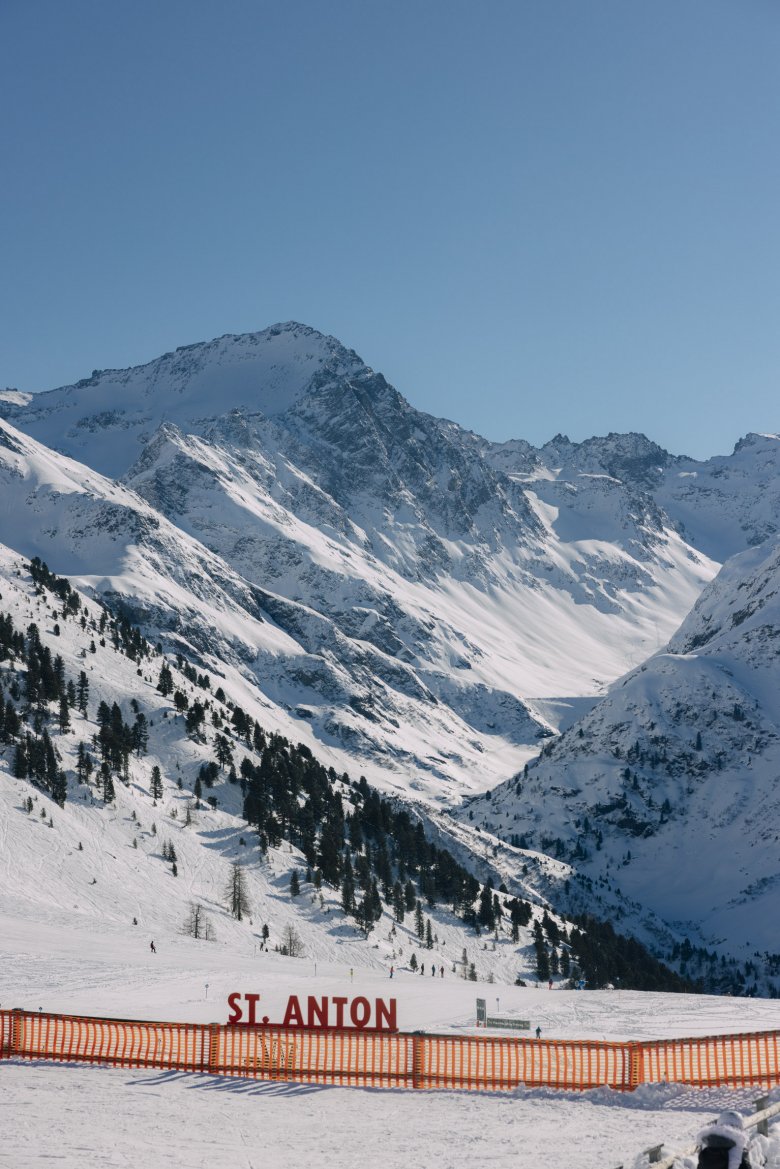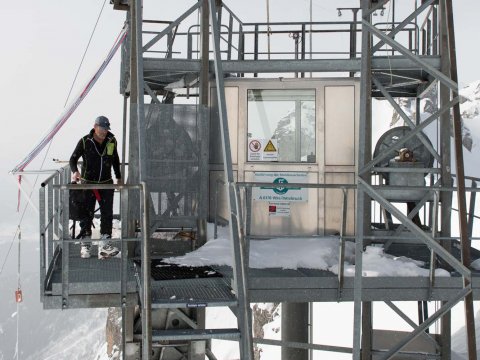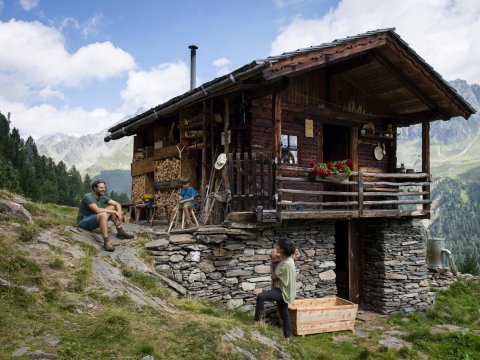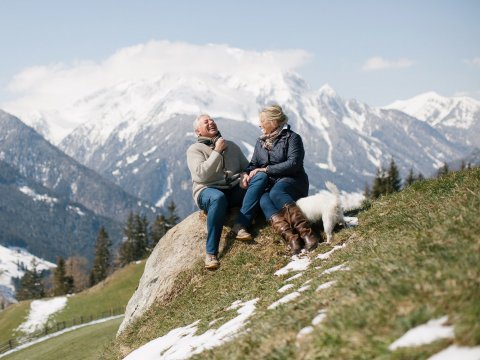Free to Ski

Ski bums are to winter what hippies are to summer – freedom-loving youngsters who work at night to ski all day. However, the ski bum has become an endangered species in recent years, even in traditional hotbeds like St. Anton. We set out to learn what it takes to be a ski bum and whether this happy-go-lucky way of life can survive in the 21st century.
Wictor Granström says he had three beers this morning. Three beers for triple courage. Why does he need triple courage? It’s backflip time.
A clear morning in February. The air is cold as ice and the sky above St. Anton is a wonderful shade of cobalt blue. The young Swede puts on his oversized sunglasses, pushes off with his poles and heads ever faster towards a ski jump in the Stanton Park. "Fuuuck it," he screams. Looking on are his friends Castanja, Wilma, Linn, Emil, Bjarke and Alfred, all in their early 20s. They are sitting at the top of the funpark in their colourful ski outfits, laughing and cheering as Wictor hurtles towards the lip.

They know that their friend has never done a trick like this before. Ever. A backflip is something you normally practise on a trampoline, maybe at the lake in summer, but certainly not in the middle of a busy funpark with a pair of skis strapped to your feet. Castanja screams with excitement. Friend Linn squeezes her hand. Alfred digs a mobile phone out of his pocket so that he can "call mountain rescue faster". But Wictor, the man with beer and without fear, delivers. He flies about five metres through the air, somehow managing to rotate backwards and bring his skis down at the very last moment for a more or less safe landing. His friends erupt into a huge cheer and charge for a celebratory hug. "A real ski bum," smiles Castanja.

Ski bums are how this group of friends from Scandinavia refer to themselves – albeit a little ironically, a little uncertainly, as if they’re not quite sure whether they have the right to claim this mythical title for themselves. "Bum" is the American term for a tramp or drifter, but not in a nasty or negative way. The definition of a ski bum could be as follows: a young person who spends the whole winter in a ski resort where they earn just enough money with a casual job as a pizza delivery boy, bartender or ski guard to finance a season ticket and a room – all with the aim of skiing as much as possible. Off-piste rather than on-slope, spontaneous rather than sensible. And at night? It's off to the clubs and discos with like-minded people for wild parties with no regrets. A life free of commitments and committed to freedom.
The dream of eternal winter
Nobody is sure how the term ski bum originated. The US magazine "Ski" published a story about ski bums all the way back in 1948. Two years later the renowned photo magazine "Life" brought the ski bum phenomenon into popular culture. The star of the scene at the time was Warren Miller, born in California in 1924, who drove from resort to resort in the USA in a ramshackle caravan searching for the best snow. He would sleep in the car park and subsisted mainly on ketchup with hot water. His films portrayed a new type of skier: always short of cash, rarely in freshly washed clothes, but skiing better than anyone else on the mountain. An adventurer and risk-taker who holds both gravity and responsibility in equal disregard.
Communities of these alpine hippies also grew in Europe, particularly in Verbier, Chamonix – and St. Anton. Scandinavians, who found the mountains at home too small, would move to the Alps to live the dream of eternal winter. And like the hippies of Goa and Morocco, some of the ski bums became hooked – on deep snow, steep lines and, in some cases, substances of the more dangerous kind.
However, in recent years, the ski bum has become an endangered species. With life in the mountains becoming more expensive, young people feel under pressure to get on the career ladder. The result is that there are fewer and fewer people willing and able to devote their lives to skiing. Influential US magazine "Outside" recently even claimed the ski-bum lifestyle is dead. But that really true? Is the ski bum a thing of the past?
The evening before the backflip, the Scandinavian friends meet up at the Hotel Rosanna in the centre of St. Anton. It is here that they all work. Castanja Kilpatrick, a blonde Dane with perfectly manicured fingernails, wears a dark green corduroy blouse and apron as she sets the tables in the restaurant for dinner. Bjarke Mikkelsen stands behind the bar and pours beers. Alfred Balschmidt, whom the others sometimes call Professor, has just finished reading a book and is now busy putting food away into a refrigerator. And Wictor Granström is busy behind the scenes keeping things running smoothly – he is the maintenance guy at the Hotel Rosanna and has just finished repairing a broken sofa.
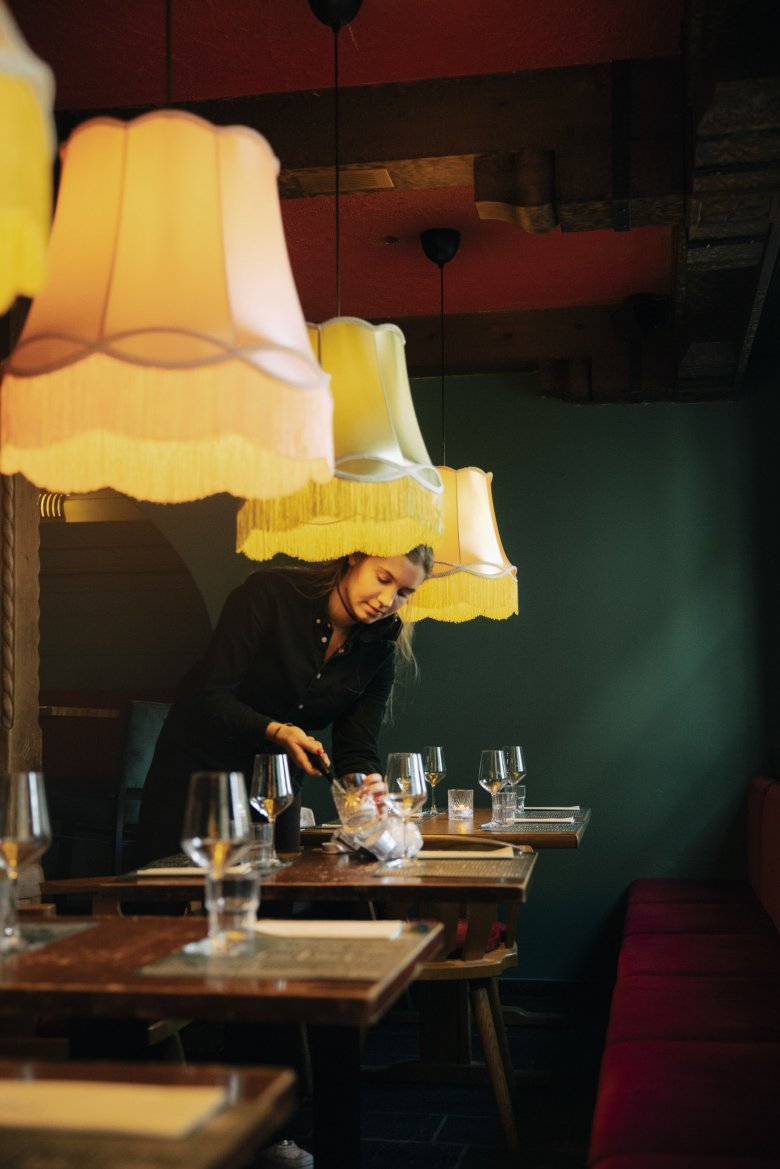
A life dictated by the lifts
Tidy and chic, the hotel restaurant on the first floor could be a trendy bar in downtown Copenhagen. The basement, where they sleep four to a room in bunk beds, is more reminiscent of an aging hostel. Strewn across the floor are ski magazines, worn socks, beer cans and empty shampoo bottles – with no windows for letting in any fresh air. The Scandinavians arrived here in autumn to help renovate the hotel – tearing down walls, replacing furniture, painting everything, until the upper floors of the Hotel Rosanna were once again ready to welcome guests. The only part of the hotel which didn’t receive any TLC was the basement. When the ski season started in mid-December, the crew shifted their attention from hard labour and handicrafts to other jobs as waiters, bartenders and caretakers. At Christmas, when the chef became unavailable at short notice, they even cooked Christmas dinner: Swedish meatballs and mashed potato.
As the final guest of the evening heads off to bed, the friends are still sitting around together in the hotel bar. There’s no party today, but Castanja has mixed her favourite drink – an espresso martini – for everyone. What she likes about life in St. Anton? It's the simplicity, she says. "At home you have a thousand questions, you're forced to figure out what you want to do with your life". Here, the only decision you have to take in the morning is whether to ski or snowboard. "It's a perfect 24 hours – and the next day we get to do it all over again."

Castanja's mother once spent an entire season in St. Anton. When she reminisced about it at the dinner table in Denmark, it sounded like a distant dream to her daughter. Skiing with like-minded people, not for a fortnight’s holiday but the whole winter. A life dictated by the lifts. If surfers dream of endless summer with perfect waves, Castanja dreamed of endless winter with perfect powder. When after leaving school she came across the job advertised by the Hotel Rosanna, she decided to follow in the footsteps of her mother and move to St. Anton, where she met the others. Her life in this ski resort in the west of Tirol is, she says, a kind of intermezzo – a time-out between the serious bits of life: school, which now lies behind her, and whatever is to come – work, training or university.
So how long can you live as a ski bum? "I love every single day," says Castanja, her eyes sparkling as she talks about afternoons of clear blue skies and powder snow, early-morning turns on the empty pistes and the picnics they hold every Wednesday lunchtime somewhere far away from the slopes. And yet Castanja admits: "I will probably just do one season." In the summer she wants to move on, travel to Malta and Spain, or maybe to Hawaii for surfing. Next year she may go to university to study business, economics, something along those lines. For Castanja, life as a ski bum is a temporary one.

It is this sanity that bothers some purists about modern ski bums. The veterans of the scene wish for a longer and more absolute devotion to the ski-bum life, a crazy all-or-nothing approach like that of Warren Miller. One veteran ski bum tells me how, when he moved from Australia to St Anton, he put together a whole skiing outfit just from the stuff he found in the lost property box at the hotel where he worked. In the morning he jumped on the back of the ski bus so he didn’t have to pay. These days, he moans, the seasonal hippies of the 21st century all have money from their parents. The full-send, do-or-dare lifestyle of a true hardcore ski-bum is slowly slipping away.
This criticism of modern ski bums is one you will often hear in St. Anton – and it is partly true. In the bars frequented by ski bums, such as the Krazy Kanguruh and Tabs, you really do meet mainly young people who say that Mum and Dad help them out financially and they just want to get away from it all for a winter. But can you blame young people for that? Isn't it a sign of the pressure young people are under these days? A world of work that does not tolerate gaps in your CV, a society that makes it increasingly difficult to live your dreams?
Back to the old school
And yet, even in St. Anton, you will still find people who embody the spirit of the old-school ski bum. For example, this man in a baseball cap, in his mid-30s, who is busy passing a ski carefully over the rotating grinder in the workshop at Skibase Arlberg. On the wall behind him hang posters of deep powder and naked women, slogans against racism and police violence. Scribbled on a piece of paper are the words "Surgery Department". As the machine grinds away at the base of the ski, its operator seems a little worse for wear. My head, he groans. Yesterday was a long one. His name is Christian Schleehauf and he has been coming to the Arlberg region every winter for ten years. He is actually a trained carpenter and originally hails from the south-west of Germany. At the end of every winter, Schleehauf says, he resolves that this will be his last. He also says this regularly to his girlfriend back home in the Black Forest. Yet the team at Skibase Arlberg always laugh when he tells them he won’t be back again next year. They all know: Schleefi, as they call him here, will be back. He knows it, too. He can't help it.
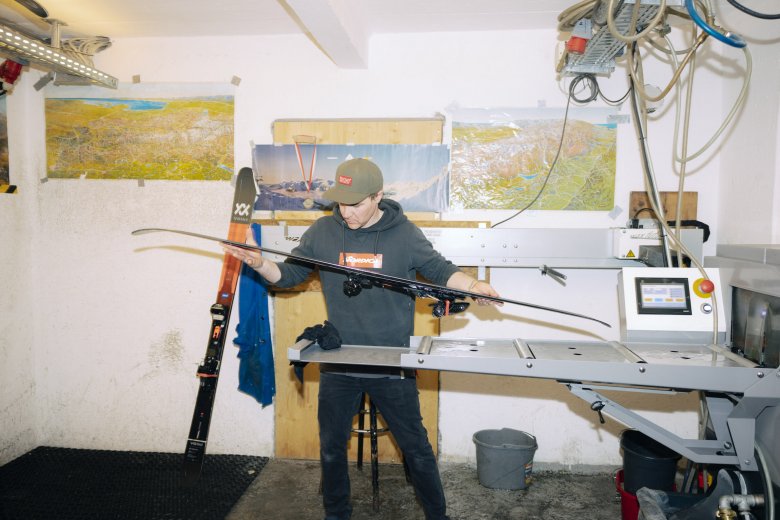
After his short morning shift, Schleehauf has the rest of the day off – for him that means one thing: skiing. As he slips into his ski socks, I spy a set of blue-grey ski boot buckles on his bare feet. I check again and realise that I am not hallucinating – the man really does have ski boot buckles tattooed onto his feet. As he leaves the shop in ski gear and with an airbag rucksack, Nadine Wallner is already waiting for him outside. She is one of Austria's best female skiers, a qualified mountain guide and a former winner of the Freeride World Tour. She has shouldered her wide powder skis and wears her sponsor's helmet on her head. Together they walk towards the gondola. A quick glance up at the mountains reveals less-than-ideal conditions: fog. For some people a reason to stay home – but not for Christian and Nadine. "Ski bums like Schleefi are the best companions for me," says Wallner. They don't mind bad weather or difficult snow conditions – and they are crazy enough to follow a freeride world champion. He doesn't really see himself as a ski bum, says Schleehauf. "How do you recognise a ski bum?” asks Wallner with a cheeky smile, before answering her own question: “Ski bums are the ones who tell you they’re definitely not ski bums".
For today, the two have chosen a route that they prefer to keep secret. Not so many people know it, so the slope is still untracked a few days after the latest snowfall. The wind is blowing. No sun. Hardly any people out and about. Riding up on the chairlift, Wallner and Schleehauf scan the slopes around them, pointing out snowdrifts that could herald avalanches and talking again about possible runs for today. They both use technical terms and code words that only people in the know are familiar with.

What do they think? Is the ski bum really at risk of becoming extinct? Wallner and Schleehauf say the situation has something of a paradox. On the one hand, there are more and more ski-mad freeriders who come to the mountains with the best equipment and high ambitions, do crazy double backflips and post GoPro videos of them on Instagram. On the other hand, most of these people also have a regular job, are studying at university – or are so successful with their Instagram accounts that they have sponsors and are chasing the dream of eternal winter. "Being a ski bum means standing in front of the supermarket on Sunday and wondering why it's closed," laughs Wallner. These days, she adds, there are only a handful of people who can be called true ski bums. One of them is “Crazy Juan”, an Argentinean daredevil with no health insurance whom Wallner and Schleehauf have in the past had to drive out of the valley for treatment on a broken leg. But apart from Juan and few old locals who just can’t stop skiing, there really aren’t many original ski bums left.
At the top, Schleehauf and Wallner glide off the chairlift and push over a ridge towards a steep rocky gully with half a metre of deep snow. Stable pack or a potential avalanche? Wallner kicks her ski into the snow several times. The last time she did this, she explains, the whole slope came loose. Not this time. Schleehauf pushes off into the gully. The snow sprays up as he makes turn after turn. He looks as light as a feather, like a dancer waltzing across a pristine white floor.
Three hours and 1,000 vertical metres of descending later, when he is back in his workshop, he says: "Sure, the scene has changed. Society has also changed. Everything has become more professional, the pressure to perform is higher. Hardly anyone wants to live in a shared flat in their mid-30s." He still lives in one, together with Jakob, a young Dane. Recently, he says, he had to ask Jakob if he could maybe wash his ski socks a little more. Is he growing old? Growing tired of the ski bum life? This year, Schleehauf says, could be a turning point for him. Should he carry on as before, come back next year? Maybe stay for good? Every winter there are fewer familiar faces, family and girlfriend become more impatient, thoughts turn inevitably to mundane things like pension contributions, buying a property, starting a family. Must everything beautiful eventually come to an end?

Back to the future
If you want to know what happens to ski bums who just couldn't stop, who kept coming to St. Anton before they finally became part of the furniture, you can arrange to meet an older gentleman by the Nassereinbahn cable car. The problem is, if you keep your eyes out for an "older gentleman", you will almost certainly miss Gunnar Munthe.
The 76-year-old bounces across the car park as if he were in his mid-twenties. His face is tanned, his upper body muscular, he walks the dog for several hours every day, goes to the gym in summer, skis in winter. But only on sunny days now. "I've skied too much in my life to put up with bad weather," says Munthe.
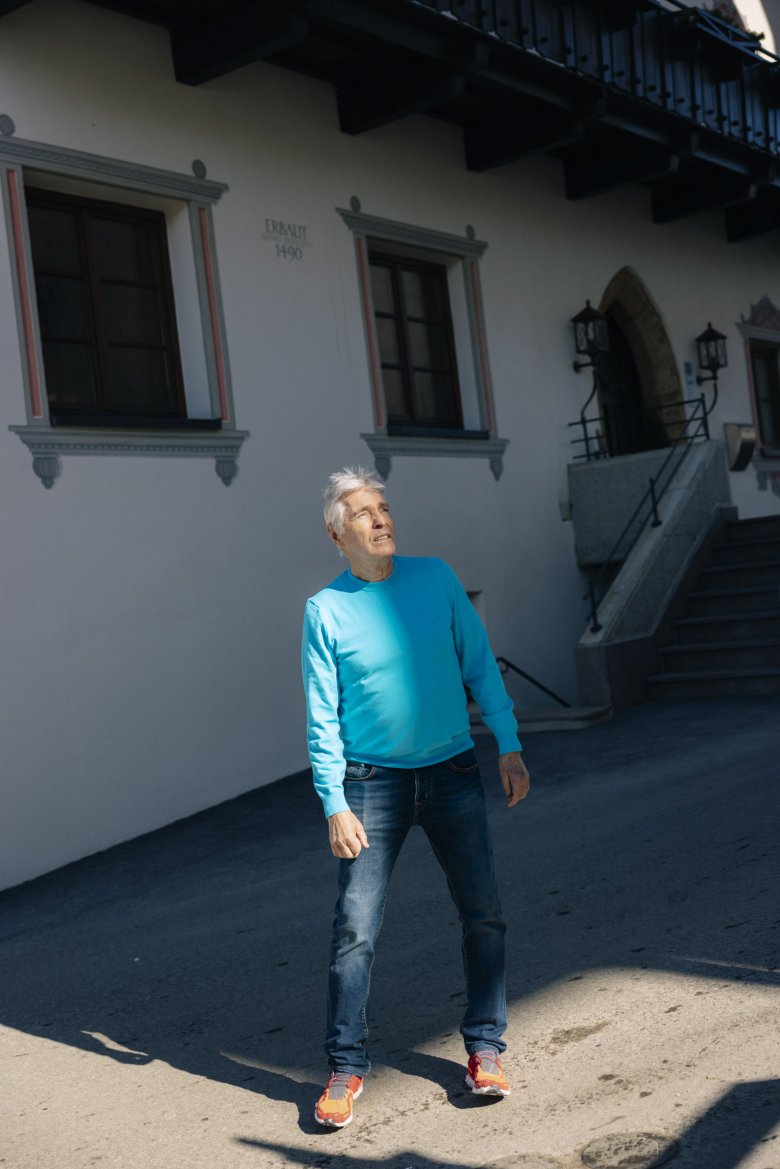
Munthe came to St. Anton over 50 years ago, also from Sweden. "Back then, when I drove into town in my old Volvo P544, I had to stop in the middle of the road and look at the mountains in the light of the rising sun. It almost took my breath away," he says.
Munthe skied like hell, always hunting the best powder – and the best party. And, unlike others, he didn't stop: "My father wanted me to study ..." But Munthe stayed. At some point he decided to put all his eggs in the St. Anton basket: He bought the Krazy Kanguruh, today still the most popular après-ski bar among young ski bums. Munthe ran this legendary bar hangout for 35 years before selling up. Today he owns a small hotel, the Reselehof. And he still skis. Like a demon.

Gunnar Munthe lets it rip on the piste so that even much younger skiers can hardly follow him. He waits at the bottom of the gondola until his companions arrive. The look on his face tells of two emotions – a certain frustration at having to wait, but also pride at still being able to show everyone how it’s done.
As he zips around the resort, Munthe also passes by Stanton Park – and meets a young man there who could have been himself 50 years ago: Wictor Granström is busy rehearsing his next backflip.
For a brief moment, the past and the future of ski bums in St. Anton meet: two men from Sweden, one old and one young. The older man skis on quickly. Fun parks, rails and loud rap music are not his world. The young man, on the other hand, pushes off towards the jump, determined to make sure his first successful backflip was more than just good luck. He wants to learn to rotate more smoothly in the air. If not this season, then next. Wictor Granström may be back in St. Anton next year – and, who knows, maybe also the one after that.
